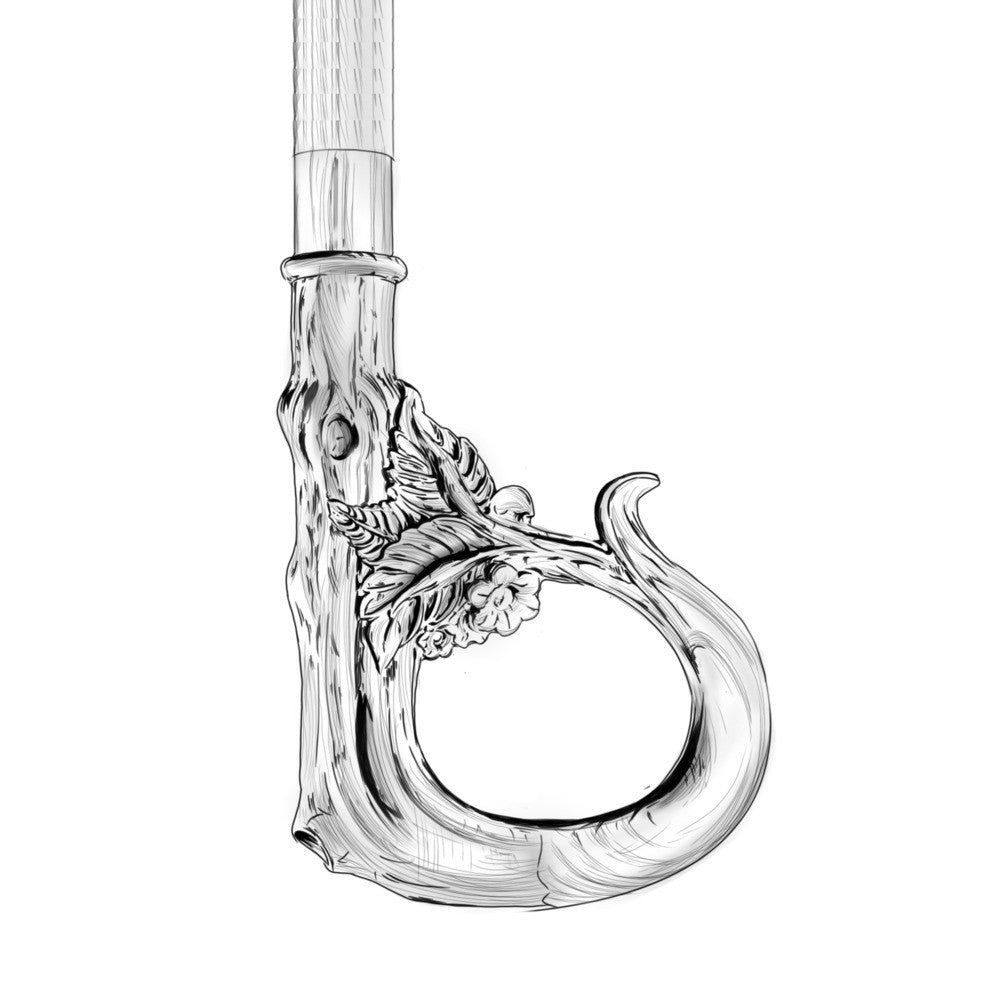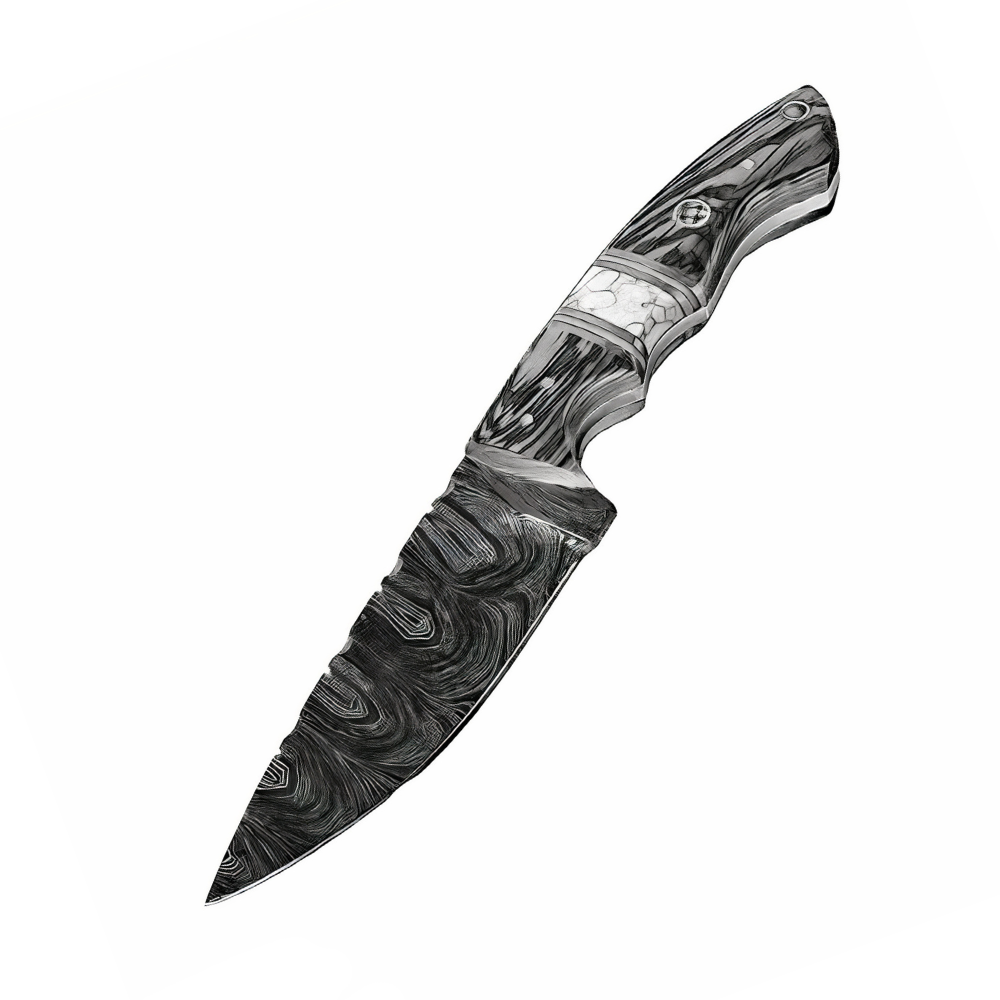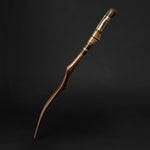You have no items in your shopping cart.
Recent Posts
-
A guide to walking cane handle materials: choosing the perfect blend of style and comfort
-
Mastering every terrain: how to use your walking cane on different surfaces
-
How to choose the right rubber tip for your walking cane
-
Crafting elegance: the best woods used in walking cane manufacturing
-
Why a walking cane makes a thoughtful and timeless gift?
-
Embracing the golden years: the grace and beauty of walking with a cane
MOST POPULAR NOW
19
Apr
Walking is a great way to stay active and healthy, but for many people, it can be a challenge. That's where a walking stick comes in. A walking stick, also known as a hiking stick or trekking pole, is a long, sturdy pole that provides support and stability while walking. In this article, we'll explore what a walking stick is, why it's important for weight loss and exercise, and the benefits of using a walking stick.
The benefits of using a walking stick for weight loss and exercise
What is a walking stick?
A walking stick is a simple device that can help you maintain your balance and stability while walking. It's typically made from a lightweight material such as wood, aluminum, or carbon fiber, and it can be adjusted to the height of the user. Walking sticks come in a variety of styles, from traditional wooden sticks to modern, high-tech poles with ergonomic grips and shock-absorbing features.

Why is it important for weight loss and exercise?
Walking is a great form of exercise that can help you lose weight, improve your cardiovascular health, and reduce your risk of chronic diseases like diabetes and heart disease. However, walking can be challenging for people who have balance or stability issues. That's where a walking stick can be helpful.
By providing support and stability, a walking stick can help you maintain proper form while walking, which can reduce your risk of injury and help you burn more calories. In fact, using a walking stick can increase the number of calories you burn by up to 20%, according to some studies. This is because the extra effort required to use a walking stick engages more muscles in your arms, shoulders, and core, which can increase your overall calorie burn.
What are the benefits of using a walking stick?
Using a walking stick has a number of benefits, including:
-
Improved balance and stability: A walking stick can help you maintain your balance and stability while walking, which can reduce your risk of falls and other injuries.
-
Reduced joint pain: By taking some of the weight off your knees and hips, a walking stick can reduce joint pain and stiffness.
-
Increased calorie burn: As mentioned earlier, using a walking stick can increase the number of calories you burn while walking, which can help you lose weight and improve your fitness.
-
Improved posture: By helping you maintain proper form while walking, a walking stick can improve your posture and reduce strain on your back and neck.
-
Enhanced cardiovascular health: Walking is already great for your cardiovascular health, but using a walking stick can increase your heart rate and provide an even greater cardiovascular workout.
In conclusion, a walking stick can be a valuable tool for anyone who wants to stay active and healthy. Whether you're looking to lose weight, improve your fitness, or simply enjoy a leisurely stroll, a walking stick can provide the support and stability you need to make the most of your walk.
How walking stick helps in weight loss and exercise?
Walking sticks have been used for centuries as a helpful tool for those who need support while walking. A walking stick is a simple device that provides balance and stability and can be helpful for people with balance issues or those recovering from an injury. In addition to providing support, a walking stick can also be beneficial for weight loss and exercise. In this article, we'll explore how walking sticks can support your body, increase your calorie burn, improve your posture and balance, and reduce stress on your joints.
How walking stick supports your body?
A walking stick can provide support to your body while walking, which can be especially helpful for people who have balance or stability issues. By providing a third point of contact with the ground, a walking stick can help you maintain your balance and stability, which can reduce the risk of falls and other injuries. A walking stick can also help to take some of the weight off of your legs, reducing the pressure on your knees, hips, and feet.
How walking stick increases your calorie burn?
Using a walking stick can also help to increase your calorie burn while walking. By engaging your arms, shoulders, and core muscles, a walking stick can provide an additional workout while you walk. This increased effort can help to burn more calories, making your walk more effective for weight loss and fitness. In fact, some studies have shown that using a walking stick can increase your calorie burn by up to 20%.
How walking stick improves your posture and balance?
Walking with a walking stick can also improve your posture and balance. By providing support and stability, a walking stick can help you maintain a more upright posture while walking, reducing the strain on your back and neck. This improved posture can also help to improve your balance, which can reduce the risk of falls and other injuries.
How walking stick reduces stress on your joints?
Walking with a walking stick can also reduce stress on your joints. By taking some of the weight off of your legs, a walking stick can help to reduce pressure on your knees, hips, and feet. This can be especially helpful for people with joint pain or stiffness, allowing them to walk more comfortably and for longer periods of time.
In conclusion, a walking stick can be a helpful tool for anyone looking to improve their health and fitness. By providing support and stability, a walking stick can increase your calorie burn, improve your posture and balance, and reduce stress on your joints. Whether you're recovering from an injury, looking to lose weight, or simply want to enjoy a more comfortable and effective walk, a walking stick can be a valuable tool to have.
Types of walking sticks
Walking sticks have become a popular tool for people who want to improve their balance and stability while walking. They are available in a variety of types and styles, each designed to meet different needs. In this article, we'll explore the different types of walking sticks available, including traditional wooden walking sticks, adjustable walking sticks, hiking poles, Nordic walking sticks, and folding walking sticks.
Traditional wooden walking sticks
Traditional wooden walking sticks are the most basic and commonly used walking sticks. They are typically made from wood and come in a variety of shapes and sizes. Traditional wooden walking sticks are sturdy and reliable, making them a great choice for people who need support and stability while walking. They are also a popular choice for people who enjoy outdoor activities such as hiking and camping.
Adjustable walking sticks
Adjustable walking sticks are a versatile type of walking stick that can be adjusted to fit different heights. They typically have a telescoping shaft that can be extended or retracted as needed. This makes them a great choice for people who want a walking stick that can be used by multiple people or for different activities. Adjustable walking sticks are also a popular choice for people who travel frequently, as they can be easily packed in a suitcase or backpack.
Hiking poles
Hiking poles are a type of walking stick that are specifically designed for hiking and trekking. They are typically made from lightweight materials such as aluminum or carbon fiber, making them easy to carry and use. Hiking poles typically have a grip handle and a strap to help secure the pole to your wrist. They also often have a pointed tip to provide traction on uneven terrain.
Nordic walking sticks
Nordic walking sticks are a type of walking stick that is designed for a specific type of walking exercise called Nordic walking. Nordic walking is a full-body workout that involves using poles to propel yourself forward. Nordic walking sticks are typically longer than traditional walking sticks and have a specific grip that allows for maximum power transfer. They also often have a pointed tip to provide traction on uneven terrain.
Folding walking sticks
Folding walking sticks are a type of walking stick that can be folded down to a smaller size for easy storage and transport. They are typically made from lightweight materials such as aluminum or carbon fiber, making them easy to carry and use. Folding walking sticks are a popular choice for people who travel frequently, as they can be easily packed in a suitcase or backpack.
In conclusion, there are many different types of walking sticks available, each designed to meet different needs. Whether you need a basic traditional wooden walking stick or a more specialized hiking pole or Nordic walking stick, there is a walking stick out there that is right for you. By choosing the right walking stick, you can improve your balance and stability while walking, making it easier and more comfortable to enjoy your favorite activities.

How to choose the right walking stick?
Walking sticks are great companions for those who love to hike, walk, or even those who require additional support and balance when walking. Choosing the right walking stick can make a significant difference in your experience and overall enjoyment. Here are some important factors to consider when choosing the right walking stick.
The right length
The length of your walking stick is crucial to your comfort and overall stability. It is essential to ensure that the length of the stick is appropriate for your height. The general rule is that the stick should reach the ground when the handle is held at waist level. However, some walking sticks come in adjustable lengths, allowing you to customize it to your specific height.
The right material
Walking sticks come in various materials, including wood, metal, carbon fiber, and even bamboo. Each material has its advantages and disadvantages, and your choice depends on your preference, budget, and the purpose of the stick. Wooden walking sticks are traditional and stylish, while metal sticks are sturdy and durable. Carbon fiber sticks are lightweight and comfortable to use, and bamboo sticks are eco-friendly and have a natural aesthetic appeal.
The right grip
The grip of your walking stick can affect your comfort and stability when walking. Walking sticks come with various grip styles, such as ergonomic grips, straight grips, and contoured grips. Ergonomic grips are designed to reduce the strain on your hand and provide additional support. Straight grips are simple and easy to use, while contoured grips are designed to fit the shape of your hand, offering superior comfort and control.
The right weight
The weight of your walking stick is an essential factor to consider, especially if you plan to use it for extended periods. Heavy sticks can be tiring to use, while lightweight sticks can reduce fatigue and allow for more extended use. Carbon fiber and bamboo sticks are some of the lightest options, while metal sticks tend to be heavier.
The right accessories
Accessories can enhance the functionality and overall experience of using a walking stick. Some accessories to consider include rubber tips to improve grip and traction on slippery surfaces, wrist straps to prevent accidental dropping, and even built-in compasses for hikers and outdoor enthusiasts.
In conclusion, choosing the right walking stick is vital to your overall experience and enjoyment. Consider the length, material, grip, weight, and accessories to ensure that you get the best walking stick for your needs.
How to use a walking stick for exercise?
Walking sticks are not only great for support and balance, but they can also be used for exercise. Incorporating a walking stick into your exercise routine can help improve your balance, strength, and flexibility. Here are some ways to use a walking stick for exercise.
Warm-up exercises
Before starting any exercise, it is crucial to warm up your muscles to prevent injury. A simple warm-up exercise using a walking stick is to hold the stick behind your back with your arms straight and palms facing down. Slowly raise the stick above your head and then lower it back down. Repeat this exercise for about a minute.
Walking with a walking stick
Walking with a walking stick is an excellent way to exercise your lower body and improve balance. Holding the walking stick with both hands, walk naturally, taking care to place the walking stick firmly on the ground with each step. This exercise can be done indoors or outdoors and can be customized to your fitness level by increasing the speed or distance.
Stretches using a walking stick
Using a walking stick for stretches can help improve flexibility and range of motion. To stretch your calf muscles, stand with your feet hip-width apart and place the ball of one foot against the walking stick. Lean forward, keeping your back straight, until you feel a stretch in your calf muscle. Hold for 10-15 seconds, and then switch sides. To stretch your hamstrings, place the walking stick behind your back and hold it with both hands. Bend forward at the waist, keeping your back straight, until you feel a stretch in your hamstring muscles. Hold for 10-15 seconds and then relax.
Upper body exercises with a walking stick
Using a walking stick for upper body exercises can help improve your posture and strengthen your arms, shoulders, and back. One simple exercise is to hold the walking stick with both hands, palms facing down, and lift it straight above your head. Hold for a few seconds, and then lower it back down. Repeat this exercise for about a minute.
In conclusion, incorporating a walking stick into your exercise routine can provide a variety of benefits for your overall health and well-being. From warm-up exercises to stretches and upper body workouts, there are plenty of ways to use a walking stick for exercise.
Tips for using a walking stick safely and effectively
Walking sticks are a great tool to aid in exercise and weight loss, but it's important to use them safely and effectively to avoid any potential injuries. Here are some tips on how to use a walking stick safely and effectively:
-
Proper grip and posture - Make sure to grip your walking stick properly, with your hands comfortably placed on the grip. Your posture should be upright and your shoulders should be relaxed. Avoid hunching over or leaning on the stick too heavily.
-
Walking technique with a walking stick - When using a walking stick, take shorter steps than you would without a stick. Place the stick about one foot in front of you, and then step forward with the opposite foot. Your walking stick should move in tandem with the opposite foot.
-
Using a walking stick on different terrains - When using a walking stick on different terrains, make sure to adjust your technique accordingly. On uphill slopes, plant the stick firmly into the ground and push yourself up with the stick. On downhill slopes, plant the stick ahead of you to provide stability and support. When walking on uneven terrain, use your walking stick to help you maintain your balance.
-
Avoiding common mistakes while using a walking stick - One common mistake people make is holding the stick too high or too low. The ideal height for a walking stick is to have your elbow bent at a comfortable angle, around 15 degrees. Another common mistake is placing the stick too far ahead of you, which can cause you to overreach and lose balance.
In conclusion, walking sticks are a great tool for exercise and weight loss, but it's important to use them safely and effectively. By following these tips on grip, posture, walking technique, and avoiding common mistakes, you can make the most of your walking stick and enjoy the benefits it provides.
Frequently Asked Questions
Here are some frequently asked questions about walking sticks:
Is walking with a walking stick a low-impact exercise?
Yes, walking with a walking stick is a low-impact exercise that can be performed by people of all ages and fitness levels. It is an excellent way to burn calories and improve your overall health and well-being.
Is using a walking stick helpful for people with arthritis or joint pain?
Yes, using a walking stick can be helpful for people with arthritis or joint pain. It reduces the stress on your joints and provides additional support, making it easier to walk.
Can a walking stick improve balance and stability?
Yes, a walking stick can improve your balance and stability while walking. It provides an additional point of contact with the ground and helps you maintain proper posture, reducing the risk of falls.
Is there a maximum weight limit for using a walking stick?
Most walking sticks have a weight limit of around 250 pounds. However, it is essential to choose a walking stick that is sturdy enough to support your weight and provides adequate stability.
How do I maintain and clean my walking stick?
To maintain and clean your walking stick, wipe it down with a damp cloth after each use to remove dirt and debris. If your walking stick is made of wood, use furniture polish or oil to keep it moisturized and prevent it from drying out.

Conclusion
Walking is one of the simplest and most effective exercises that you can do for your health. However, adding a walking stick to your routine can take your workout to the next level. In this article, we've discussed the benefits of using a walking stick for weight loss and exercise, the different types of walking sticks available, how to choose the right walking stick, how to use it safely and effectively, and some frequently asked questions.
A walking stick provides support and balance, allowing you to walk longer and faster, which leads to increased calorie burn. It also engages your upper body muscles, making it a full-body workout. Furthermore, using a walking stick reduces stress on your joints and improves your posture, which is beneficial for people with arthritis or joint pain.
When choosing a walking stick, it's important to consider the length, material, grip, weight, and accessories. The right walking stick can make your workout safer and more effective. To use your walking stick properly, you should maintain proper grip and posture, use the correct walking technique, and avoid common mistakes.
Walking with a walking stick is a low-impact exercise that is suitable for people of all ages and fitness levels. It can improve your balance and stability, reduce your risk of falls, and help you maintain your independence as you age. There is no maximum weight limit for using a walking stick, but it's important to choose a stick that can support your weight.
To maintain and clean your walking stick, you should wipe it down with a damp cloth after each use and store it in a dry place. Avoid exposing it to extreme temperatures or moisture, which can damage the wood or metal.
In conclusion, using a walking stick is a simple and effective way to boost your fitness and health. Whether you're a beginner or an experienced walker, a walking stick can help you achieve your fitness goals and stay active for years to come.
Also Purchased
Modern Sculpted Black Skull Handle and Gold Accents
Introducing a striking combination of craftsmanship and luxury, the Modern Sculpted Black Skull Handle Walking Stick with Gold Accents is designed for individuals who value both style and functionality. Handcrafted...
From $185.00
ArtWalkingSticks™ MAGIC Walking Cane, Handmade - Make to Order
This piece of art is created for those who value details. We make one of a kind, handcrafted wood and resin canes. Our Wooden Canes are completely unmatched in creativity....
$430.00
Stylish Solid Chestnut Striped Umbrella with Knob End
Elegance redefined: designer solid chestnut umbrella Step into a world of refined fashion with our Designer Solid Chestnut Striped Umbrella. Crafted with precision and an eye for detail, this umbrella...
$305.00
Fashionable Lion Shoehorn Long Handle, Pearly Brown Shaft, Handmade
Introducing our Fashionable Lion Shoehorn, a handcrafted, long-handled shoe horn with a pearly brown shaft that's both stylish and practical. The intricate Lion design adds a touch of elegance to...
$220.00
Carved Lion Head Comfortable Walking Cane, Unusual Crazy Walking Stick
Want to add a touch of royalty to your style? Look no further than our carved lion walking cane. People have used decorative lions in décor since ancient times, and...
$182.00
Umbrella with Eagle Handle, Fashion Umbrella For Men
Make a bold and fashionable statement with our Umbrella with Eagle Handle - a unique and functional accessory designed for men. The striking eagle handle is the highlight of this...
$305.00
Artisan Toucan-Shaped Handle Walking Cane, Stylish Daily Support
Discover the perfect balance of art and functionality with this hand-carved walking cane. Featuring a vibrant toucan-shaped handle, this unique accessory is crafted from ash wood and hand-painted with intricate...
$85.00
Cherub Blue Handle Exclusive Handcrafted Custom Knife with Sheath
Introducing a truly exceptional creation, exclusively crafted by the author. This extraordinary knife showcases an innovative design that combines functionality and elegance.The handle boasts a unique hybrid composition that is...
$380.00


































